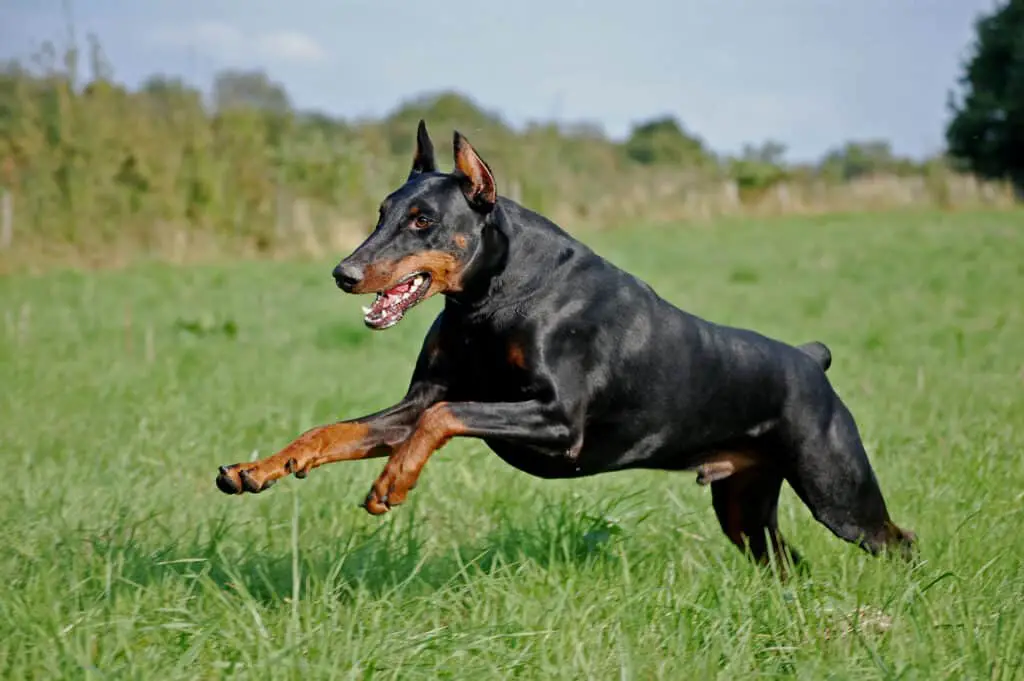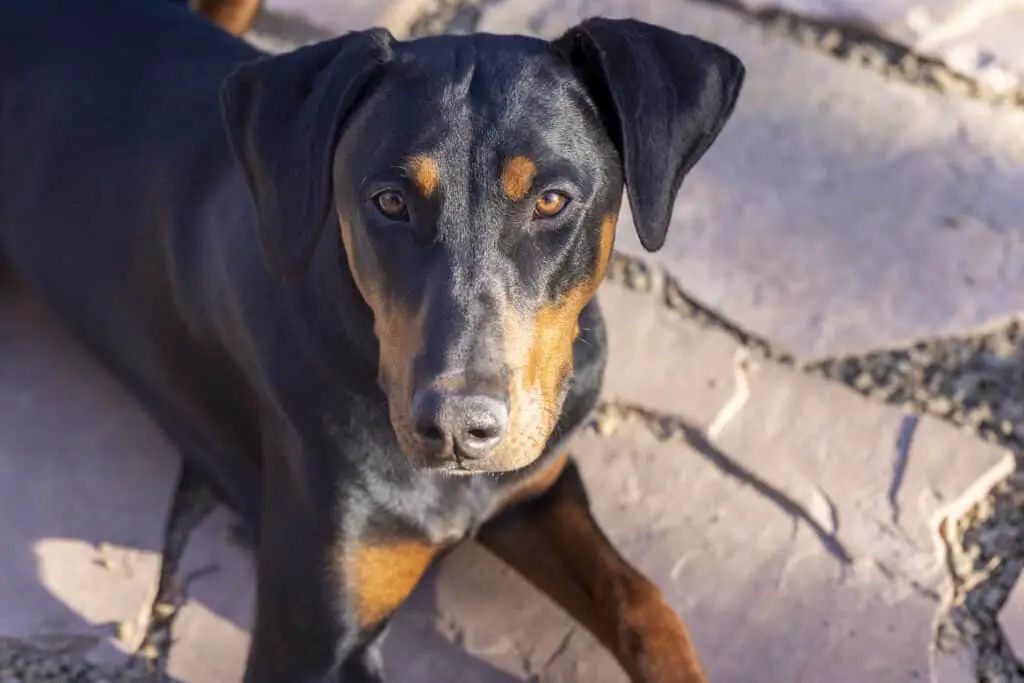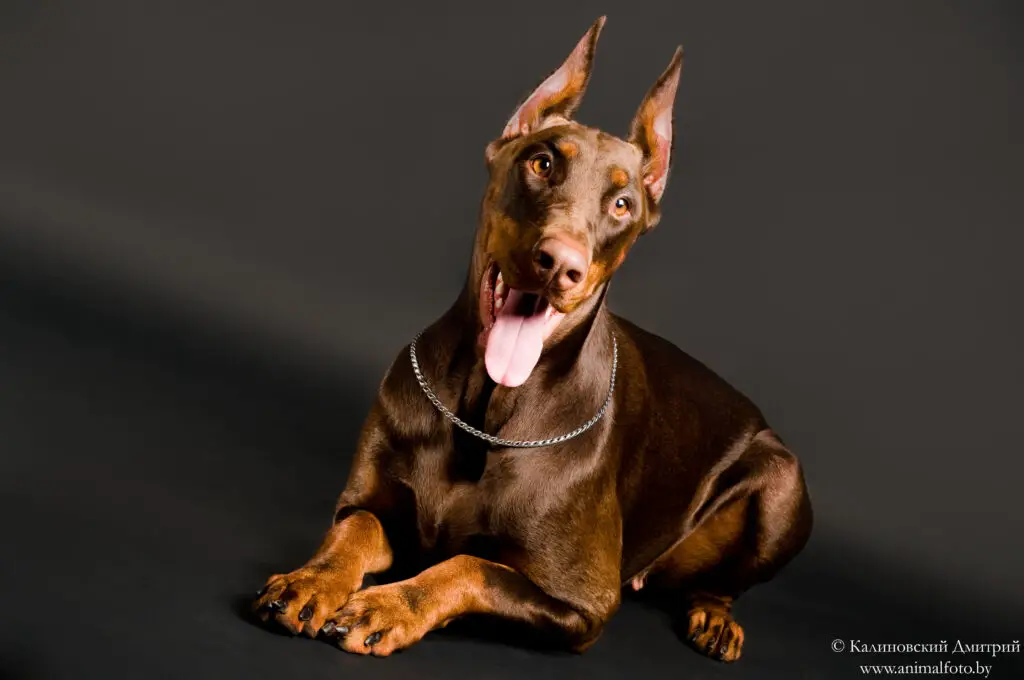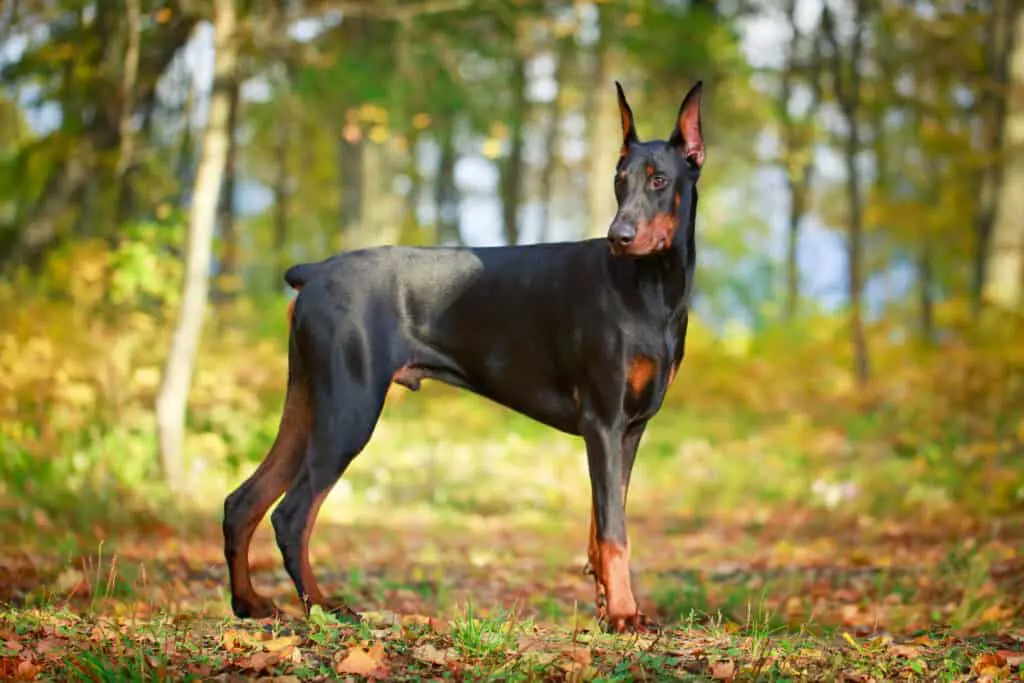Our website is supported by our users. We sometimes earn money when you click an affiliate link and make a purchase. This is at no extra cost to you and helps us to create quality content. Thank you for your support. For all that have shown us such wonderful support, we thank you from the bottom of our hearts!
Doberman Pinschers are a breed of dog known for their sleek and powerful physique, keen intelligence, and loyalty to their owners. Originally bred in Thuringia, Germany in the late 1800s by Louis Dobermann, a tax collector, the Doberman Pinscher was created to be a guard dog.
Today, they are still used as working dogs in law enforcement and the military, but also make great family pets.

One of the most distinctive features of the Doberman Pinscher is their cropped ears and docked tail, although these practices are now illegal in many countries. They have a short, smooth coat that comes in a variety of colors including black, red, blue, and fawn.
Doberman Pinschers are typically medium to large sized dogs, with males standing around 27-28 inches tall and weighing about 70 pounds, while females are slightly smaller at around 26 inches tall and weighing about 60-65 pounds.
If you are considering adding a Doberman Pinscher to your family, it is important to understand the breed’s temperament and exercise needs. They are known for being loyal and protective of their owners, but can also be wary of strangers and other dogs.
They require regular exercise and mental stimulation to stay healthy and happy, and may not be the best choice for first-time dog owners.
History of the Doberman Pinscher
The Doberman Pinscher is a breed that was developed in Germany in the late 1800s. The breed was named after Louis Dobermann, a tax collector from Apolda, Germany, who is credited with creating the breed. Dobermann wanted a dog that could protect him while he was collecting taxes, and he used his access to a variety of dog breeds to create the Doberman Pinscher.
Louis Dobermann was not a professional dog breeder, but his breeding experiments were reputedly involved in the early development of the Doberman Pinscher. He used a variety of breeds to create the Doberman, including the German Pinscher, which was one of the primary breeds used in the development of the first Doberman Pinschers.
During World War II, the Doberman Pinscher was used as a war dog by the Marine Corps. The breed was used for a variety of tasks, including guard duty and search and rescue missions. The Doberman Pinscher was a valuable asset to the military, and the breed’s intelligence and loyalty made it an ideal candidate for military service.
Today, the Doberman Pinscher is still used as a guard dog and companion. The breed is known for its intelligence, loyalty, and protective nature. The Doberman Pinscher is a popular breed and is recognized by the American Kennel Club. In fact, they have their own club, the Doberman Pinscher Club of America.
In conclusion, the Doberman Pinscher has a rich history that dates back to the late 1800s.
Louis Dobermann, a tax collector from Apolda, Germany, is credited with creating the breed. The Doberman Pinscher was used as a war dog during World War II and is still used as a guard dog and companion today. The breed is known for its intelligence, loyalty, and protective nature.
Physical Characteristics of the Doberman Pinscher
The Doberman Pinscher, also known as Dobie or simply Doberman, is a powerful and muscular breed that is known for its alertness and intelligence. This breed is medium to large in size and has a smooth, short coat that comes in four main colors: black, blue, red, and fawn. The coat may also have rust-colored markings, which are brown in color. Some Dobermans may have small patches of white on their chest or feet.
Males typically stand at 26 to 28 inches at the withers, while females stand at 24 to 26 inches. The breed typically weighs between 60 to 100 pounds for females and 75 to 100 pounds for males. The Doberman Pinscher has a well-proportioned body with a sleek and athletic build, which gives them great strength and endurance.
The breed’s gait is hard and athletic, with a brisk and efficient stride. The Doberman Pinscher is a working dog that was originally developed for guarding and protection, and they have retained their athleticism and strength.
They are also highly intelligent and trainable, making them excellent companions for those who are willing to put in the time and effort to train them properly.
In terms of temperament, the Doberman Pinscher is loyal, energetic, and attentive. They are also highly alert and make excellent watchdogs. While they are known for their strength and athleticism, they are also gentle and affectionate with their families.
It’s worth noting that the Doberman Pinscher is often compared to the Rottweiler and the Black and Tan Terrier, as they all share similar physical characteristics and working dog traits. However, the Doberman Pinscher is a distinct breed with its own unique set of characteristics and temperament.
They are also often compared to the Miniature Pinscher, which is a smaller breed that shares some physical traits with the Doberman Pinscher, but has a different temperament and personality.
The average lifespan of a Doberman Pinscher is 10-12 years. However, with proper care and attention, they can live longer. Regular exercise, a healthy diet, and regular check-ups can help ensure that your Doberman lives a long and healthy life.
Temperament & Training of the Doberman Pinscher
The Doberman Pinscher is a highly energetic and intelligent dog breed that is known for its loyalty and fearlessness. They are often used as police and military dogs due to their guarding and tracking abilities.
However, with proper training and socialization, they can also make great companions and therapy dogs.
Dobermans have a reputation as having aggressive personality traits, but this is largely a myth. While they can be protective of their families, they are not inherently aggressive.
However, improper training and socialization can lead to aggressive behavior, so it’s important to train your Doberman properly and to socialize them with other dogs and people from a young age.
Also because they are energetic dogs, making sure they get enough exercise to burn off excessive energy is a good idea.
They are known for their intelligence and eagerness to please, which makes them easy to train but not generally recommended for first time dog owners. Positive reinforcement training methods work best with Dobies, as they respond well to praise and rewards.

Socialization is also an important aspect of training a Doberman Pinscher. They can be aggressive towards young children, other dogs and pets if not properly socialized from a young age. It is important to expose them to different people, animals, and environments to ensure they are well-adjusted and friendly.
A well-trained and socialized Doberman can make an excellent family dog. However, as with any dog that is around children, there must be close supervision.
The energy level and playfulness of the Doberman Pinscher make them great candidates for dog sports such as agility and rally. They are also affectionate and loyal towards their owners, making them great companions.
However, their vigilant and alert nature also makes them excellent guard dogs.
Overall, the Doberman Pinscher is a highly intelligent and loyal dog breed that requires proper training and socialization. With the right training, they can excel in police and military work, as well as make great companions and therapy dogs.
Health Issues of the Doberman Pinscher
As with any breed, the Doberman Pinscher is prone to certain health issues that you should be aware of. It’s important to take your Doberman for regular check-ups and to keep an eye out for any signs of illness or discomfort. Here are some of the health issues that are most commonly associated with the Doberman Pinscher:
Albinism
Albinism in Doberman Pinschers is a rare genetic condition characterized by the absence of melanin, the pigment responsible for skin, hair, and eye color. Albino Dobermans have a distinctive appearance with a complete lack of pigmentation, resulting in a white coat, pink skin, and blue eyes. The condition is associated with an increased sensitivity to sunlight, making these dogs more susceptible to sunburn and skin cancers.
Beyond the cosmetic aspects, albinism can also lead to vision and hearing impairments in affected Dobermans. Responsible breeders actively avoid breeding dogs with albinism due to the associated health challenges and the risk of passing on the genetic mutation.
While albino Dobermans may capture attention due to their unique appearance, potential owners should be aware of the special care requirements and health considerations associated with this condition, seeking guidance from veterinarians to ensure the well-being of these unique and delicate animals.
Gastric Dilatation-Vovulus (GDV)
Gastric dilatation-volvulus (GDV), commonly known as bloat, is a life-threatening condition affecting Doberman Pinschers and other deep-chested breeds. In GDV, the stomach fills with gas and twists upon itself, obstructing blood flow and preventing the release of built-up gas.
Dobermans, due to their conformation, are particularly predisposed to this condition. The rapid onset of GDV can lead to shock, organ damage, and death if not promptly addressed.
Early symptoms may include restlessness, unproductive vomiting, and abdominal distension. Swift veterinary intervention is crucial to relieve the torsion and restore blood flow. Treatment typically involves decompression of the stomach, stabilization, and surgery to correct the torsion and prevent recurrence.
Prevention strategies include feeding multiple small meals, avoiding strenuous exercise after meals, and considering prophylactic gastropexy surgery. Doberman owners should be vigilant for signs of GDV and seek immediate veterinary attention to improve the chances of a positive outcome.
Dilated Cardiomyopathy
One of the most serious health issues that can affect Dobermans is dilated cardiomyopathy (DCM). This is a condition where the heart becomes enlarged and weakened, which can lead to heart failure. Dobermans are genetically predisposed to DCM, so it’s important to have regular cardiac screenings to catch any signs of the condition early.
Hip Dysplasia
Hip dysplasia is a common condition in many large dog breeds, including the Doberman Pinscher. This is a condition where the hip joint doesn’t develop properly, which can lead to arthritis and other joint problems. Regular exercise and a healthy diet can help prevent hip dysplasia, but it’s important to have your Doberman screened for the condition.
Hypothyroidism
Hypothyroidism is a condition where the thyroid gland doesn’t produce enough hormones, which can lead to weight gain, lethargy, and other health issues.
Dobermans are prone to hypothyroidism, so it’s important to have regular blood tests to monitor their thyroid function.
Dobermans have a reputation for being aggressive, but this is largely a myth. While they can be protective of their families, they are not inherently aggressive.
However, improper training and socialization can lead to aggressive behavior, so it’s important to train your Doberman properly and to socialize them with other dogs and people from a young age.
von Willebrand’s Disease (VWD)
Von Willebrand’s disease (VWD) is a hereditary bleeding disorder that affects Doberman Pinschers. It results from a deficiency or dysfunction of von Willebrand factor, a protein crucial for blood clotting.
Dobermans with VWD may experience prolonged bleeding after injuries or surgeries, nosebleeds, and, in females, excessive bleeding during heat cycles or whelping.
Diagnosis involves specialized blood tests to assess von Willebrand factor levels and function. While there is no cure for VWD, management focuses on minimizing bleeding risks.
This may involve avoiding certain medications and surgeries, and in severe cases, administering blood products or von Willebrand factor replacement therapy.
Breeders can reduce the prevalence of VWD by responsible breeding practices, including genetic testing and avoiding mating carriers of the disease. Doberman owners should be aware of the potential for bleeding issues and work closely with veterinarians to develop a care plan that ensures the well-being of their pets.
Grooming Your Doberman Pinscher
Taking care of your Doberman Pinscher’s grooming needs is an important part of keeping them healthy and happy. Here are some tips on how to properly groom your Doberman Pinscher:
Brushing
Doberman Pinschers have a short, smooth coat that is easy to maintain. However, they do shed, so regular brushing is necessary to remove loose hair and keep their coat shiny.
Brushing your Doberman once a week with a dual sided pin brush and soft-bristled brush help keep their coat in good condition.
You may want to invest in an Equigroomer for a light de-shedding tool.
Bathing
Doberman Pinschers have a single-layered coat that does not require frequent bathing. You should only bathe your Doberman once every 2-3 months, unless they get particularly dirty or smelly.
When you do bathe them, use a mild shampoo that is specifically formulated for dogs. Be sure to rinse thoroughly to avoid leaving any soap residue on their skin.
This tool, the ELEGX Pet Grooming Bath Massage Brush, helps to get down to the skin and it gives your dog a nice massage.
Cutting Fur/Hair
Doberman Pinschers do not require any special haircuts or grooming techniques.
Clipping or Grinding Nails
Doberman Pinschers’ nails should be trimmed monthly, unless they spend a lot of time outdoors, which can naturally wear down their nails.
You can use a pair of dog nail clippers or a nail grinder to trim your Doberman’s nails. Be sure to avoid cutting the quick, which is the blood vessel that runs through the nail.
Check out our article on the best nail grinders if you need help choosing a grinder.
And if you are nervous about nail care, check out our article on how to grind your dog’s nails.
Dental Care
Like all dogs, Doberman Pinschers are susceptible to dental problems such as gum disease and tooth decay. To keep your Doberman’s teeth healthy, brush their teeth regularly with a dog-specific toothpaste and toothbrush. You can also provide them with dental chews or toys to help keep their teeth clean.
One popular brand dental chews is GREENIES Original Regular Natural Dog Dental Care Chews. These contain wheat and wheat gluten which are possible allergens.
Another brand that is popular is the Nylabone Nutri Dent Natural Dental Chew Treats, which also contains wheat.
Cleaning Ears
Doberman Pinschers are prone to ear infections, so it’s important to keep their ears clean and dry. Check their ears weekly for signs of redness, swelling, or discharge.
Use a cotton ball or soft cloth to clean the inside of their ears with a gentle ear-cleaning solution recommended by your veterinarian. Be sure to avoid inserting anything into their ear canal, as this can cause damage.
Another great option are these Pet MD Ear Cleaning wipes. They are convenient and space saving.
By following these grooming tips, you can help keep your Doberman Pinscher healthy, happy, and looking their best.
Owning a Doberman Pinscher
If you’re considering owning a Doberman Pinscher, there are a few things you should know about the costs associated with this breed. Here are some important sub-sections to consider:
Cost of Purchase
The cost of purchasing a Doberman Pinscher can vary depending on where you get the dog from. Adopting a Doberman Pinscher from a shelter can cost anywhere from $50 to $500, while purchasing a puppy from a breeder can cost anywhere from $1,000 to $3,000.
Keep in mind that the price can vary based on the breeder’s reputation, the dog’s lineage, and other factors.
Maintenance Costs
Doberman Pinschers are relatively low-maintenance dogs, but they still require regular exercise, grooming, and medical care. You can expect to spend around $500 per year on food, toys, and other supplies.
Additionally, annual veterinary checkups can cost around $200 per year, with additional costs for vaccinations, heartworm prevention, and other medical needs.
Special Training
Doberman Pinschers are known for their loyalty and protective nature, but they also require special training to ensure they are well-behaved and safe around other people and animals.
Expect to spend around $500 to $1,000 on obedience training and socialization classes.
Medical Costs
Doberman Pinschers are prone to certain health problems, such as hip dysplasia, heart disease, and cancer. You should plan to spend around $1,000 to $2,000 per year on medical costs, including routine checkups, emergency care, and treatment for any health issues that may arise.


Though controversial, some owners choose to have their Doberman’s ears cropped and tail docked for aesthetic reasons. If you choose to have these procedures done, it’s important to have them done by a professional veterinarian.
Grooming Costs
Doberman Pinschers have short, smooth coats that require minimal grooming. However, they do shed moderately, so regular brushing can help keep shedding under control. You can expect to spend around $50 to $100 per year on grooming supplies.
Adopting a Doberman Pinscher
If you’re interested in adopting a Doberman Pinscher, start by researching local shelters and rescue organizations. You can also check with the American Kennel Club for a list of reputable breeders in your area.
Finding Breeders
If you’re interested in purchasing a Doberman Pinscher from a breeder, be sure to do your research and find a reputable breeder with a good reputation. Look for breeders who are members of the American Kennel Club and who follow responsible breeding practices.
Fun Facts
- Dobies were originally bred as guard dogs in Germany in the late 1800s.
- Doberman Pinschers are known for their loyalty and protective nature, making them excellent guard dogs and companions.
- Doberman Pinschers are highly intelligent and respond well to positive reinforcement training.
- Despite their reputation as aggressive dogs, Doberman Pinschers can be friendly and affectionate with their owners and other people and animals when properly trained and socialized.
Frequently Asked Questions
What are the different colors of a Doberman Pinscher?
Doberman Pinschers come in four different colors: black, red, blue, and fawn. The black and tan combination is the most common, but all colors are recognized by the American Kennel Club.
How big do Doberman Pinschers get?
Doberman Pinschers are a medium to large breed, with males standing 26 to 28 inches tall at the shoulder and weighing between 75 to 100 pounds. Females typically stand 24 to 26 inches tall and weigh between 60 to 90 pounds.
What is the temperament of a Doberman Pinscher?
Doberman Pinschers are known for their loyalty, intelligence, and protectiveness. They are often used as guard dogs and police dogs due to their keen instincts and ability to be trained. However, they can also be affectionate and playful with their families.
Are Doberman Pinschers good guard dogs?
Yes, Doberman Pinschers are known for their excellent guarding abilities. They are highly alert and protective of their families and property, and will not hesitate to defend them if necessary. However, proper socialization and training are important to ensure they do not become overly aggressive.
Are Doberman Pinschers good family pets?
Yes, Doberman Pinschers can make great family pets. They are loyal and affectionate with their families, and can be good with children if socialized properly. However, they do require a lot of exercise and mental stimulation, and may not be the best fit for households with small children or elderly individuals.
The Bottom Line on the Doberman Pinscher
Doberman Pinschers are a breed of working dog that were developed in Apolda, Germany, by Karl Friedrich Louis Dobermann in the late 19th century. They are sleek, agile, and powerful dogs that can stand up to 28 inches tall and weigh up to 100 pounds.
They have a short, smooth coat that can be black, blue, fawn, or other colors.
Dobermans are known for their loyalty, intelligence, and protectiveness, but they can also display aggression if not properly trained and socialized. They are natural protectors and can be trained to be effective guard dogs, but they can also make excellent family pets when raised in a loving home and provided with adequate training and exercise.
If you are considering getting a Doberman Pinscher, it is important to understand the pros and cons of the breed. On the one hand, they are intelligent, loyal, and protective dogs that can make great companions and guard dogs.
They can be prone to certain health issues, such as hip dysplasia and dilated cardiomyopathy, and they require a lot of exercise and mental stimulation to stay healthy and happy.
Overall, Doberman Pinschers are a fascinating breed of dog that can be great companions and protectors when properly trained and socialized. If you are considering getting a Doberman, be sure to do your research and find a reputable breeder or rescue organization that can help you find the right dog for your lifestyle and needs.
Please read our Legal Disclaimer









